Beyerdynamic are a well known name in the headphone industry and in the professional audio world. I have toyed with the idea of purchasing Beyers on many occasions, but never pulled the trigger… until now.
Specifications
- Style: Semi-open
- Frequency response: 5 – 50,000 Hz
- Impedance: 600 ohms
- Nominal SPL: 102 dB
Overview
The T1s sit squarely at the top of the Beyerdynamic tree of headphones and were their first Tesla headphone. The Tesla nomination relates to the amount of magnetic force in the driver mechanism of the headphone. In general terms, 1 tesla of magnetic force is massive and it means that the drivers are very sensitive. I want to equate it to a car with lots of power and huge brakes, but that doesn’t account for the handling and the T1s are also nimble and agile, not just quick to stop and start.
In a speaker (or headphone) driver, the ability of the voice coil (the bit that drives the movement) to respond rapidly and accurately is the key to transparent and accurate sound as well as efficient creation of volume without requiring massive power. At 600 ohms, the T1s would traditionally be considered “hard to drive”, but the Tesla driver means it produces volumes comparable to 350 ohm headphones like the Sennheiser HD6X0s given equal amounts of power.
I have seen measurements that would suggest the T1’s Tesla driver is quite noisy in terms of distortion at various frequencies and it doesn’t measure as favourably as drivers like those found in the Sennheiser HD800s, but the proof’s in the pudding for me and I wonder if sometimes technical inaccuracies can lend themselves to more enjoyable experiences – tube amplifiers are a perfect example where the distortion and “inaccuracy” of tubes actually makes them more musical and enjoyable. I try not to get caught up in too much sound science because it can interfere with the enjoyment of music, but I wanted to mention here that the measurements aren’t everything based on what I’m actually hearing. I’m not saying the measurements are wrong or irrelevant, just that there might be more to it and it’s the resultant experience that really matters.
While we’re talking impedance, I’ve always favoured high impedance systems with “traditional” driver setups because, if they have sufficient power, they tend to provide better sound to my ears. I’ve always put this down to the high impedance helping to damp and control driver movement. So, if we combine the Tesla design’s claimed agility and sensitivity with the high impedance’s damping factor, this should make for an amazing headphone.
Design & Comfort
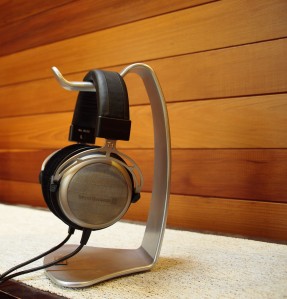 The T1s are designed almost identically to their siblings, the DT880s, DT990s, T90s, etc. It’s a design that is clean and functional, but attractive. On the T1s, the round cups are made of metal and feel solid, but light in the hand. Each earpiece is covered with soft, black velour pads and the headband is made of leather and is nicely padded.
The T1s are designed almost identically to their siblings, the DT880s, DT990s, T90s, etc. It’s a design that is clean and functional, but attractive. On the T1s, the round cups are made of metal and feel solid, but light in the hand. Each earpiece is covered with soft, black velour pads and the headband is made of leather and is nicely padded.
All-in-all there’s nothing special about the external design of the T1s, but everything’s done right. They’re all quality materials and it appears to be a case of function and form being equally considered. The end result is a very comfortable headphone on par with the likes of the HD650s which have long been my standard measure of comfort.
There are two other design features worth mentioning.
Cable Entry
 The cables for the T1s enter on the base of each earcup unlike many headphones that choose a single entry and then run a cable through the headband. Although this design might make the T1s a little more fiddly to store and put on and off, I believe it’s a good design as I’ve often wondered about the quality of the cable used to run through headbands. This way you know that each driver is receiving an identical signal through identical length and quality cables. That may sound picky, but at this level I think it’s worth consideration.
The cables for the T1s enter on the base of each earcup unlike many headphones that choose a single entry and then run a cable through the headband. Although this design might make the T1s a little more fiddly to store and put on and off, I believe it’s a good design as I’ve often wondered about the quality of the cable used to run through headbands. This way you know that each driver is receiving an identical signal through identical length and quality cables. That may sound picky, but at this level I think it’s worth consideration.
The T1 cables aren’t removable which is concern for some, but many reports claim the stock T1 cable to be excellent and I certainly have felt no need to change it. There are always services to recable if you really feel the need, but I don’t see myself ever walking that path (despite being a big believer in the improvements offered by the right cable) because I think Beyer did it well to begin with.
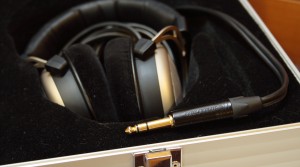 The cable entry is sturdy and well reinforced so I wouldn’t expect any troubles at all from normal usage. Similarly sturdy is the large, gold-plated 6mm Neutrik plug which also boasts solid strain relief and reinforcement.
The cable entry is sturdy and well reinforced so I wouldn’t expect any troubles at all from normal usage. Similarly sturdy is the large, gold-plated 6mm Neutrik plug which also boasts solid strain relief and reinforcement.
There’s no doubting that the build quality of the T1s and all parts attached are excellent. To top it off, they come with a lightweight metal box with a moulded foam interior for storing and transporting the flagships. Bravo Beyer for doing a great job of designing a headphone with every piece at the same level of outstanding design quality.
Angled Drivers
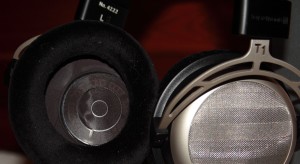 The other design feature I want to highlight is the angled driver mounting.
The other design feature I want to highlight is the angled driver mounting.
Hopefully you can see in the image to the left that the inside of the ear cup (left side in this image) has the driver offset and sitting behind a semi-transparent baffle. It’s hard to capture clearly in the image, but the driver is placed forward of the centre of the cup and tilted back. The result is that the sound enters the ear from the front, not the side, when you’re wearing the headphones. Beyerdynamic and Sennheiser both have this angled driver design and for good reason – it works. The angled drivers create a far more natural presentation of the sound and the imaging and the staging that results is nothing short of exceptional.
Sound
When someone spends $1000+ on a pair of headphones they expect some pretty exceptional sound so are the T1s worth the dough? You bet!
The T1s are an interesting headphone – as are most flagships. They have followers who love them and others who will tell you they’re a complete waste of money. For me they are worth every cent and do what they do better than anything I’ve heard so far in my headphone journey. So I guess I should explain what it is exactly that they do.
In general terms, the T1s offer a crystal clear window into your music with perhaps a slight rosy tint. They probably aren’t 100% accurate in the strictest sense, but they don’t add musicality or warmth at the expense of detail and resolution. The number one reason I love these headphones is because they are enjoyable with everything that I have every listened to… provided they are connected to a decent amp. Let me explain.
Treble
The treble presentation is the most debatable aspect of the T1s. They have the “Beyer spike” at 8-9kHz which can cause some issues, but I believe it is also the source of the T1’s magic. (Note: this final statement is based on opinion and some experimentation only so please take it with many grains of salt.)
The treble of the T1s is quite smooth overall, but the spike can bite given the wrong track through the wrong source. I personally found that it was a matter of getting used to it (my T1s were second-hand so I can’t comment on burn-in). Today, if I drive my T1s with my Audio-gd NFB-5.2, Bottlehead Crack, or Bottlehead SEX, the results are all quite listenable.
Early on, I did find the solid state edginess of the NFB-5.2 to cause some troubles with the T1s, but I think that was also partly because I was coming from the ultra-smooth HD650s.
Many T1 users report great results when paired with tube amplifiers and I have to agree – the T1s are at their sweetest with tubes.
Treble Performance
You’ll start to see a theme here soon, but I’ll start by saying that the T1’s treble is accurate, precise and agile. There’s plenty of extension right up to the highest frequencies, but the drop-off above 1kHz keeps the sound smooth.
Detail and texture in the treble is outstanding with cymbals and percussion sounding textured and rich. Sometimes the T1s treble will even let you in on secret slip-ups made by engineers. I was listening to a George Michael track one day and thought I had a piece of hair stuck in one of the drivers because of an annoying buzz / vibration in one channel only. I swapped the RCA channels over to check if my new headphones were temporarily stuffed and discovered that the buzz was in the recording – a recording I’ve had for around 10 years and never before heard in this way!
Of course, highly resolving treble (especially with an 8-9kHz emphasis) will tend to show you some flaws in terms of noise and jitter in your system. I certainly notice the limitations of my DAC now. Even though it’s a good DAC, it’s not up to the standards of the T1 and will be finding a new home soon to make room for something more suitable. I also found that I benefited from an upgraded USB cable and different, better tubes in my Crack amp.
Midrange
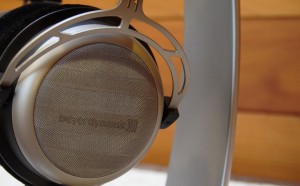 I didn’t expect incredible midrange from the T1s because everything I’d read seemed to talk about their treble presentation (for better or worse).
I didn’t expect incredible midrange from the T1s because everything I’d read seemed to talk about their treble presentation (for better or worse).
I continue to be amazed by the midrange quality from the T1s. The mids are smooth and clean with incredible texture and detail. Some headphones seem to create great mids by pushing them forward and smoothing over the bumps. The T1 seems to create greater mids by showing you everything there is to hear, but doing it smoothly and gently somehow. The nearest analogy I can give is that it’s like the ultimate sports touring car where you can feel everything that’s happening through the steering wheel and chassis, but you’re completely comfortable while driving all out in it.
I absolutely love the way the T1s present pianos, synths, drums (specifically toms) and guitars. Everything has texture that I’ve never heard before in the recordings. Pianos have the same depth that you hear when they’re live, every drum has texture and depth, synths and guitars have character, buzz, texture and detail. It really is a magical experience to rediscover your music library with the T1s.
I promised a theme when I spoke about the treble and that theme is agility. The thing which makes the T1 so special to my ears is its ability to move effortlessly from each sound to the next. Nothing ever gets muddy. Everything is clearly in its place, but still a part of the overall musical picture.
Bass
I was coming from the Fischer Audio FA-011 Limited Editions when I first tried on the T1s and the Fischers are a hard act to follow when it comes to bass quality and quantity. The T1s don’t deliver the same quantity of bass as the 011 LEs, but the bass they deliver is probably more accurate while the 011 LEs are more on the fun side.
The bass from the T1s is solid and punchy – perhaps a little forward of neutral, but beautifully balanced with the overall sound. The bass supports and complements the overall presentation from the T1s without muddying or clouding the sound or being overshadowed by other frequencies.
The impressive part of the T1s bass is its depth. The T1s bass truly goes all the way down and you can clearly hear (and feel) rumbles from as low as 30Hz and perhaps lower as I haven’t formally checked.
Once again, the delivery of the bass from the T1 is agile, just as it is with the mids and treble. Fast bass passages are clean and punchy while deep rumbles will vibrate your ears in impressive fashion while the mids and treble sing pure and clear over the top. The bass on the T1s doesn’t stand out in any way during listening, but that’s exactly why it’s brilliant.
Staging and Imaging
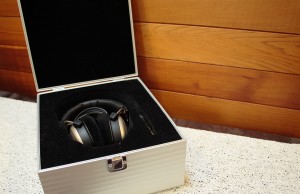 The angled driver design is one of the key features of the T1s along with the >1 tesla of magnetic flux (energy / force). As explained earlier, the angled drivers are meant to deliver the sound waves to the ears in a more natural way which is supposed to result in better imaging. Well the Beyerdynamic sound engineers weren’t wrong. The imaging and staging from the T1s is exceptional, bettered perhaps only by the Sennheiser HD800s.
The angled driver design is one of the key features of the T1s along with the >1 tesla of magnetic flux (energy / force). As explained earlier, the angled drivers are meant to deliver the sound waves to the ears in a more natural way which is supposed to result in better imaging. Well the Beyerdynamic sound engineers weren’t wrong. The imaging and staging from the T1s is exceptional, bettered perhaps only by the Sennheiser HD800s.
Staging
The stage from the T1s extends a little outside the head to the left and right while also being quite tall and as deep as any headphone I’ve heard yet. It might not quite extend in front of you, outside the head, but it’s close – right at your forehead if not slightly beyond it.
For me, the staging is pretty close to perfect – perhaps it is perfect? I feel like anything significantly larger could become less coherent or a bit unnatural whereas the T1’s staging is natural and realistic while still being large enough to fool me regularly into checking for sounds outside of the headphones. For example, just this morning I was listening to “Gator Blood” from Mark Knopfler’s new album, Privateering. I fired up the Bottlehead Crack and plugged in the T1s while my fiancée was still asleep. No sooner had the track begun than I took a massive double-take as a reached for the volume knob thinking that my desktop speakers were connected and active. Even after convincing myself that they couldn’t be on, I still had to lift the T1 earcups away from my ears to check.
That kind of epic imaging doesn’t happen on every track, but it’s more a reflection of: (a) getting used to the sound of the headphones and (b) variations in recording quality limiting the performance of the headphones.
Imaging
Equal to the quality of the stage created by the T1s, the imaging is absolutely spot on. Instruments are clearly placed in all three dimensions and you can hear a singer’s voice higher than the guitar they’re playing and in front of the orchestra behind and beside them. I love the way instruments leap out of the background on the T1s, not in an artificial way, but just cleanly and clearly. Lower level headphones I’ve heard seem to blend from one instrument / sound / texture to the next like a painter allowing one colour to bleed into the next. If other headphones are slightly blurry in this regard, the T1s deliver everything in high definition. Sounds are crisp, sharp and defined, but not emphasised, edgy or separated – everything is coherent, musical, exciting and enjoyable.
Summary
I can honestly say that there isn’t anything I dislike about the Beyerdynamic T1s. It’s true that they will reveal a poor DAC, amp or recording and may sound harsh as a result (more so with a poor DAC or amp than poor recordings), but this is more because they are true to the source rather than them being flawed and difficult to drive. They also do seem to pair really well with tube amplification because of the smoother presentation, but I have also enjoyed them from solid state amps like the Audio-gd NFB-5.2, Aune S2 Panda Mk2, and Matrix M-Stage amp, all of which are mid-level at most so it’s not like you have to break the bank on an amp to enjoy the T1s. That said, you will reap major benefits as you upgrade your source units with the T1. As with any top-end headphones, they scale very well with better gear giving outstanding results.
I am yet to find a track or genre that doesn’t sound great on the T1s and I know from much discussion on Head-fi’s T1 thread that I’m not alone in that regard. To me, these could be the ultimate all-rounder flagship. Other headphones like the LCD-2, HD800s, etc. may do certain things better, but I doubt you’ll find a headphone that does anything better (without possibly getting into electrostatic territory which I can’t comment on).
Final Comments
 There are a number of mods around for the T1 including mods using felt, cotton wool, and acoustic foam inside the earcups to dampen some of the treble. I experimented with the felt mod when I first received the T1s, but every version I tried resulted in tamed highs, but a reduced soundstage and a loss of something magic about the T1s. I kept feeling like they were good with the mod, but exceptional and addictive without the mod.
There are a number of mods around for the T1 including mods using felt, cotton wool, and acoustic foam inside the earcups to dampen some of the treble. I experimented with the felt mod when I first received the T1s, but every version I tried resulted in tamed highs, but a reduced soundstage and a loss of something magic about the T1s. I kept feeling like they were good with the mod, but exceptional and addictive without the mod.
 I haven’t exhausted all options so I’m not discounting the possible benefits of some of the other mods discussed, but the best things I found to maximise the T1’s performance are a good system including a good USB cable (if using computer audio), a good DAC, and a nice amp (tube or solid state, but my preference is towards tube).
I haven’t exhausted all options so I’m not discounting the possible benefits of some of the other mods discussed, but the best things I found to maximise the T1’s performance are a good system including a good USB cable (if using computer audio), a good DAC, and a nice amp (tube or solid state, but my preference is towards tube).


